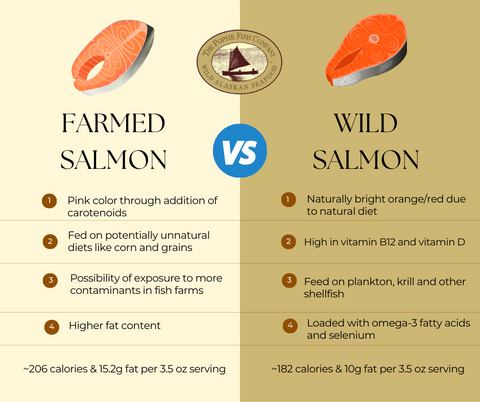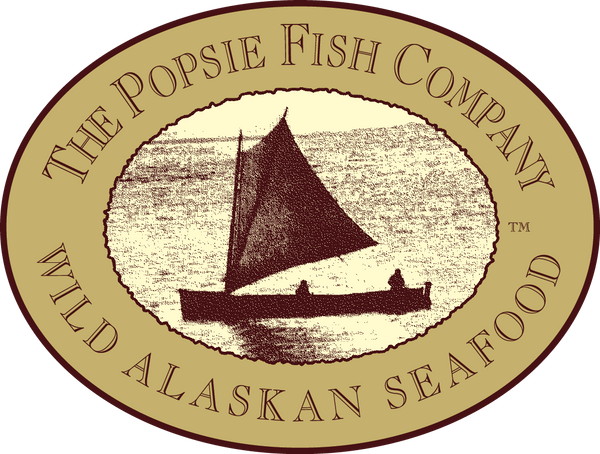FAQ
Frequently Asked Questions
Are all your fish wild caught?
Yes, all of our fish - Sockeye Salmon, Halibut, Pacific Cod, and Sablefish (Black Cod) - are sustainably caught in Alaska. Read more about all our wild-caught fish options here.
What is the difference between wild caught salmon and farmed salmon?

Ultimately, the choice comes down to personal preference, values, and priorities. Are you craving the bold flavors and untamed spirit of wild caught fish, or do you appreciate the convenience and stability of farm raised options? If you agree more with the latter, you should click over to our shop where you can have the convenience of nutritious wild caught fish delivered right to your door to fill your freezer for anytime you're craving a seafood feast! Read more about wild vs farmed fish here.
Are your fish fresh or frozen?
Our fish are flash frozen, which we like to say makes our fish "fresher than fresh". Flash freezing - also called blast freezing - is a process that preserves the fresh qualities of the food that is being frozen. It is the process of blasting extremely cold air at a very high speed across a food product in order to freeze that product as quickly as possible. When freshly caught fish are flash frozen, their taste, color, texture and nutritional value are preserved, and product safety is ensured. (Bacteria have little to no opportunity to multiply under these quick-freeze conditions, so the food remains free of harmful microorganisms.) Read more about flash freezing in our article: Flash Frozen Fish is Fresher than Fresh?
Are there additives in your fish?
No. Our fish never contain any additives. All of our fish varieties are wild caught fresh from Alaskan waters, and then promptly flash frozen to preserve quality and nutrients, without any additives.
What's the difference between salmon portions and a salmon fillet?
A wild caught salmon portion is a cut of a wild caught salmon fillet that's generally rectangular in shape and cut perpendicular to the spine. A fillet is the side of a fish that's cut parallel to the spine. Our salmon fillets are ~1.5 lb each and our salmon portions are cut into ~6 oz pieces. Portions are the perfect option when feeding one or two people whereas fillets are often preferred in group settings.
Is your fish safe for sushi?
Yes. When inquiring whether the fish you buy is “sushi-grade,” what you really want to know is, “Are your fish safe to eat raw?” Those in the business - and that would include us - refer to these fish as being sashimi grade.
However, just to be clear, the government does not “grade” fish. A fish is labeled “sushi grade - or “sashimi grade” by the seller. So it is vitally important for you to be able to know and trust the seller.
For salmon to be sold as “sashimi grade,” they must be high quality salmon that are frozen, and kept frozen, properly. “Sushi grade” and “sashimi grade” fish - those terms are used almost interchangeably - are caught quickly, bled upon capture and gutted soon after. Then they must then be handled according to the strict guidelines set by the FDA. Those guidelines always include these requirements for freezing:
Freezing at an ambient temperature of -31°F (-35°C), or below, until solid, and storing at an ambient temperature of -4°F (-20°C), or below, for 24 hours; these conditions are sufficient to kill parasites.
The Popsie Fish Company's fish check all of these boxes. Our fish are caught quickly, bled upon capture and gutted soon after. Since our fish is flash frozen after being headed and gutted, they qualify for the temperature requirements, making them safe to eat raw.
What's the best way to thaw frozen fish?
There are two ways to safely thaw frozen fish:
- In the refrigerator overnight. This is absolutely the safest, best way to thaw that beautiful piece of fish. The cool temperature of the refrigerator inhibits the growth of harmful bacteria and maintains the quality of the fish.
- In a sealed bag under cool running water. You can defrost right in the sealed, vacuum-packed bag containing the fish. Or, if you’re using fish packaged another way, you can place your raw, frozen fish into a tight, resealable bag. Fill a bowl with cool water and submerge the bag, using a weight on top if necessary.
Read more about the do's and don'ts of thawing fish here.
Do you have recipes?
Of course! Check out our recipe blog for hundreds of our favorite recipes. Don't be afraid to try a recipe that features one kind of fish on a different kind! These recipes are versatile whether you order Sockeye Salmon, Halibut, Pacific Cod, or Sablefish (Black Cod).
Do you ship internationally?
Unfortunately, our family business isn't equipped to internationally ship "direct to your door" quite yet. However, we are open to discuss shipping wholesale orders internationally. If you are out of the United States and interested in wholesale, email our wholesale manager Amy: amy.dunnavant@popsiefishco.com
How can I track my order?
All online orders will receive an order confirmation email. Your shipping confirmation and tracking number will be emailed on the day items are shipped when a shipping label is created. Occasionally, there are weather delays or delays during peak holiday periods that are beyond our control. We ship your product to arrive frozen. Please take the time to track your package and anticipate your delivery date and time so you can retrieve your order in a timely manner, so it remains frozen. We are not liable for orders that are not retrieved in a timely manner. We DO NOT ship to APO/FPO or PO Boxes.
When will my order arrive?
-
We offer free shipping on all orders. Typically, orders arrive 1-2 days from when we ship them out, on dry ice. We ship all online orders on Tuesdays and Wednesdays from a distribution center in New Jersey.
-
Yes, we catch and process your fish in Alaska. We utilize this distribution center to save on shipping and reduce in-transit thaws on our online shipments.
